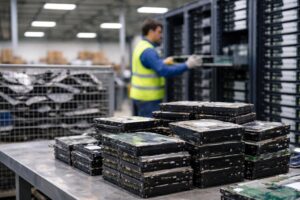Data centers are turning to superconductors in their quest for better energy efficiency. These remarkable materials can transmit electricity without any resistance, which eliminates power loss. With growing energy demands and the need to slash carbon footprints, superconductors in data centers can revolutionize power distribution, storage, and computing efficiency. This article examines superconductor applications, difficulties, new advancements, and much more. Now let’s get started.
The Basics of Superconductivity
A thorough grasp of the principles behind superconductivity is necessary. It helps to completely appreciate the possible implications of superconductors in data centers. The science underlying this phenomenon and some of its salient features will be seen in this section.
Superconductivity: Clearing the Basics
The foundation of superconductivity is quantum physics. In this, some materials radiate magnetic fields and show zero electrical resistance when chilled below a threshold temperature. This special quality prevents heat loss and permits continuous electrical current flow. Additionally, it has been extensively researched and used by various industries. It includes particle accelerators and medical imaging.
Types of Superconductors
Superconductors primarily come in two types: Type I and Type II. Most type I superconducting materials are pure metals. At extremely low temperatures, often below 30 Kelvin, they turn superconducting. Examples include lead, mercury, and aluminum.
On the other hand, type II superconductors are frequently complex compounds or alloys. They can hold onto their superconducting state under larger magnetic fields and at higher temperatures. Moreover, these comprise superconductors operating at high temperatures. This group of materials includes yttrium barium copper oxide & niobium-titanium alloys.
The Critical Temperature
When a material becomes superconducting, it reaches its critical temperature or Tc. Traditional superconductors have a low Tc, requiring expensive cooling equipment. Nevertheless, the 1980s saw the discovery of high-temperature superconductors. It gave way to many new applications. Once materials are heated above 77 kelvin or boiling point, they become superconductive. Therefore, they can serve better in rеаl-lіfе situations, for instance, data centers.
Potential Applications of Superconductors in Data Centers
Superconductors in data centers provide several intriguing options for raising energy efficiency. Some of the most promising applications or energy efficiency innovations with Superconductors and their possible advantages will be seen in this section.
Superconducting Power Transmission
Power transmission in data centers can be one of the most important uses for superconductors. Conventional power distribution copper cables have resistive losses. These lead to energy waste and heat production. On the other side, superconducting power lines can carry electricity with almost no loss. So, this can result in significant energy savings in massive data centers.
High-power density sections of data centers can benefit especially from superconducting power transmission systems. it includes server racks and cooling systems. Additionally, these solutions can improve overall energy efficiency. It can also reduce the strain on cooling infrastructure by lowering power losses and heat generation.
Superconducting Transformers and Power Converters
Power conversion and transformation is yet another exciting use for superconductors in data centers. Resistance and core losses cause efficiency losses in conventional transformers and power converters. On the other hand, the efficiency of superconducting transformers and converters can be substantially greater. It possibly reaches 99.9% or more.
These highly efficient components have the potential to drastically lower energy losses in data center power distribution systems. This is especially the case in sizable establishments with several voltage conversion phases. Superconducting transformers can also save space and enhance power density in data center designs. That’s because they’re usually lighter and smaller than the traditional ones.
Superconducting Magnetic Energy Storage/SMES
SMES provide a novel approach to data center short-term energy storage. These devices store energy in a superconducting coil’s magnetic field. As a result, it enables quick and highly efficient cycles of charge and discharge.
Furthermore, SMES systems in data centers can provide advantages, such as:
- Increased power quality through voltage fluctuation smoothing
- With quicker reaction times than conventional battery-based systems, the uninterruptible power supply (UPS)
- Load leveling to lower peak electricity requirements and related expenses
Modern data centers have dynamic power requirements that SMES systems are especially well-suited to meet. This is due to their high efficiency and quick reaction times.
Superconductors in Data Centers: Challenges and Considerations
Superconductors in data centers show potential for a range of applications. However, before they are widely used, a few important issues need to be resolved. The most important problems and elements that require fixing will be covered in detail in this section.
Cooling Requirements
The requirement for extremely high cooling is one of the primary obstacles to the use of superconductors. So, cryogenic cooling systems are still necessary for superconductors that operate at greater temperatures. This is to stay in their superconducting condition. Moreover, some of the efficiency improvements can be countered by the added complexity and energy consumption brought about by this cooling need.
To tackle this difficulty, scientists are investigating cutting-edge cooling technologies. It includes cryocoolers and creative designs for cryogenic systems. Furthermore, further efforts to create superconductors in data centers that operate at ambient temperature can one day render specialized cooling systems unnecessary.
Cost Considerations
Superconductor technology would need a large initial outlay of funds to be implemented in data centers. Superconducting materials, specialized cooling systems, and associated infrastructure can be expensive to produce and install. Additionally, data center operators would need to carefully balance the one-time capital investment. This is against the ongoing cost reductions from higher energy efficiency.
The price of superconductor technology is predicted to drop as production methods and research advances. Moreover, it could take some time, though, before the economics support its widespread use in data centers.
Integration with Existing Infrastructure
Another major problem is integrating superconductor technology into the current data center architecture. The majority of data centers are built using traditional electrical systems. So, it adds superconducting components to them might be difficult and disruptive.
Furthermore, the industry may need to create hybrid solutions that enable the progressive integration of superconductor technology. Moreover, whole new data center designs can be developed to fully utilize superconducting technologies. This might provide notable benefits in terms of performance and energy efficiency.
Current Research and Development Efforts
Superconductor uses for data centers are still being researched, despite the obstacles. Several of the field’s potential advancements and continuing initiatives will be highlighted in this section reflecting the future of data centers.
Breaking Temperature Barriers
Scientists are pushing the limits of superconductivity. They’re exploring new materials that work at higher temperatures. Furthermore, recent breakthroughs involve hydrogen-rich compounds under extreme pressure. These show promise for room-temperature superconductors. It’s still early days, though. The goal is to make superconductors in data centers more practical for everyday use. This could revolutionize data center efficiency. Researchers are also looking into exotic materials like cuprates and iron-based compounds. So, every discovery brings us closer to superconductors that don’t need extreme cooling.
Quantum Leaps: Crossover Innovations
Quantum computing is driving superconductor innovations when it comes to the future of data centers. Many quantum computers use superconducting circuits. Furthermore, this overlap is sparking new ideas for data centers. Advances in materials and cooling systems are happening fast. Control electronics are getting more sophisticated too. So, these improvements could benefit traditional computing. We might see quantum-inspired solutions in future data centers. Additionally, the two fields are sharing knowledge and pushing each other forward. Hence, it’s an exciting time for superconductor technology.
Scaling Up: From Prototypes to Power Grids
Real-world testing of superconducting cables is underway. Projects like AmpaCity in Germany are leading the charge of superconductors in data centers. They’ve installed kilometer-long superconducting cables in urban grids. Moreover, these demonstrations are crucial, showing how the technology performs in real conditions. Additionally, engineers are tackling challenges like cable joints and cooling systems. They’re also studying long-term reliability. Success in these energy efficiency innovations with Superconductors could pave the way for data center applications. So, it’s a step towards a more efficient power distribution on a large scale.
To Sum Up
Superconductors in data centers promise to transform energy efficiency. However, challenges persist and cooling needs, costs, and integration issues remain hurdles. Yet, ongoing research is expanding possibilities. Achieving sustainable data centers will require innovative solutions and industry-wide collaboration. Superconductors in data centers are just one exciting avenue in this pursuit.
To gain deeper insights, consider attending the Energy Efficiency for Data Centers Summit Asia in Singapore on September 5-6, 2024. This event brings together industry leaders, researchers, and innovators. They’ll discuss cutting-edge topics like advanced cooling, AI optimization, and renewable energy integration. Furthermore, the summit offers a comprehensive overview of the latest developments. Additionally, it provides valuable networking opportunities with experts.
It’s critical to keep up with developing technology and best practices. It helps stakeholders and data center operators make wise choices. Moreover, these decisions will shape our digital future. So, take advantage of this opportunity to join the conversation and Contribute to the ongoing transformation of data center efficiency!




